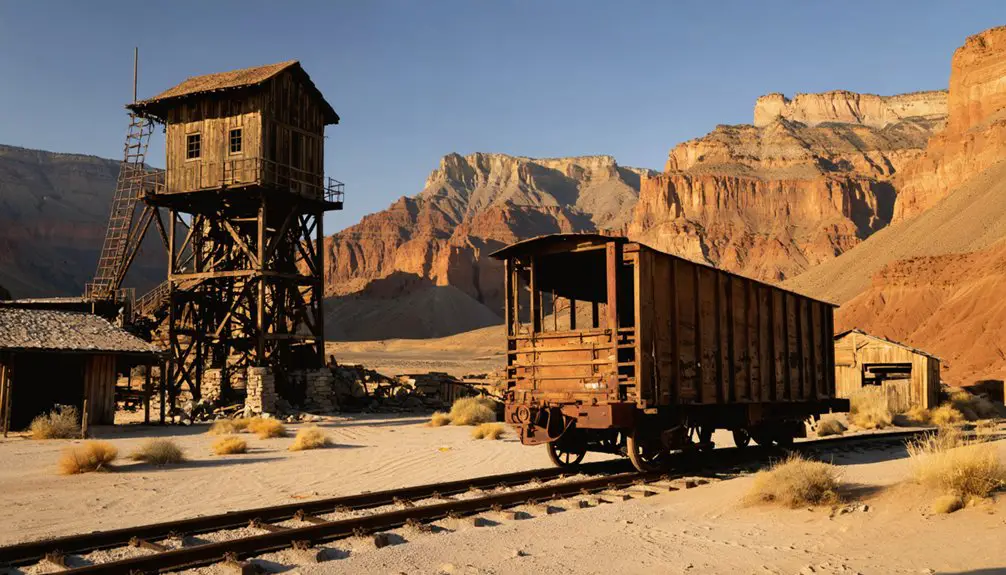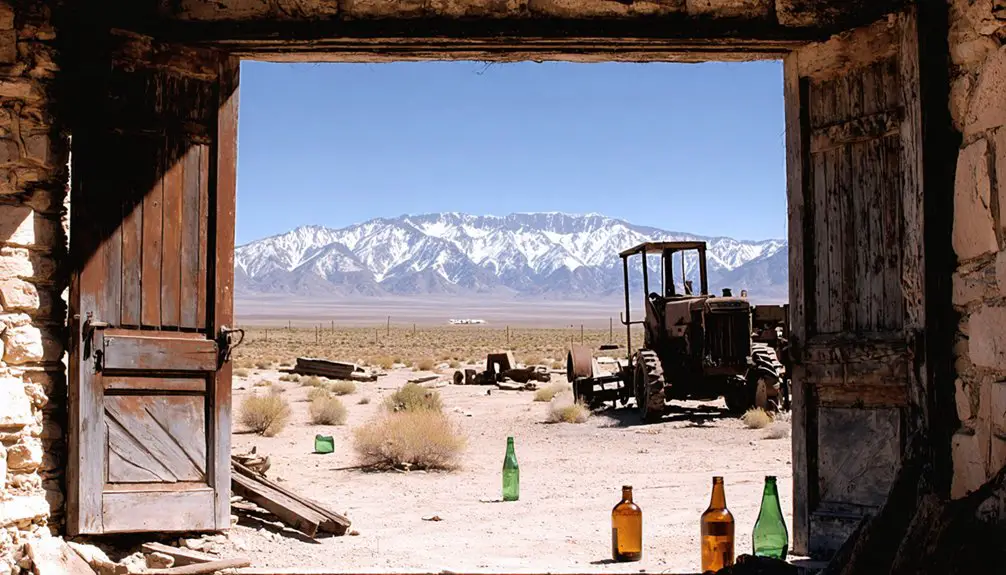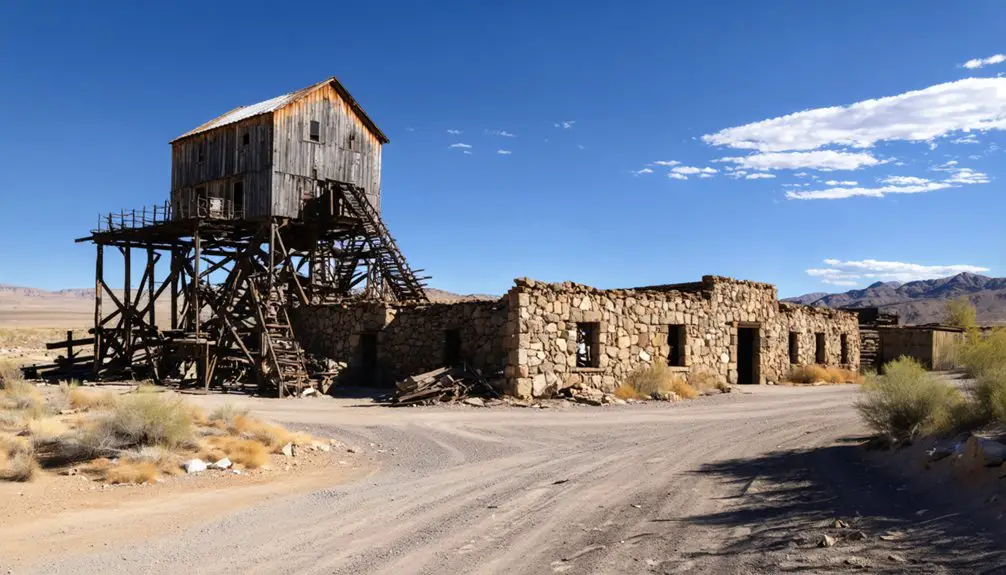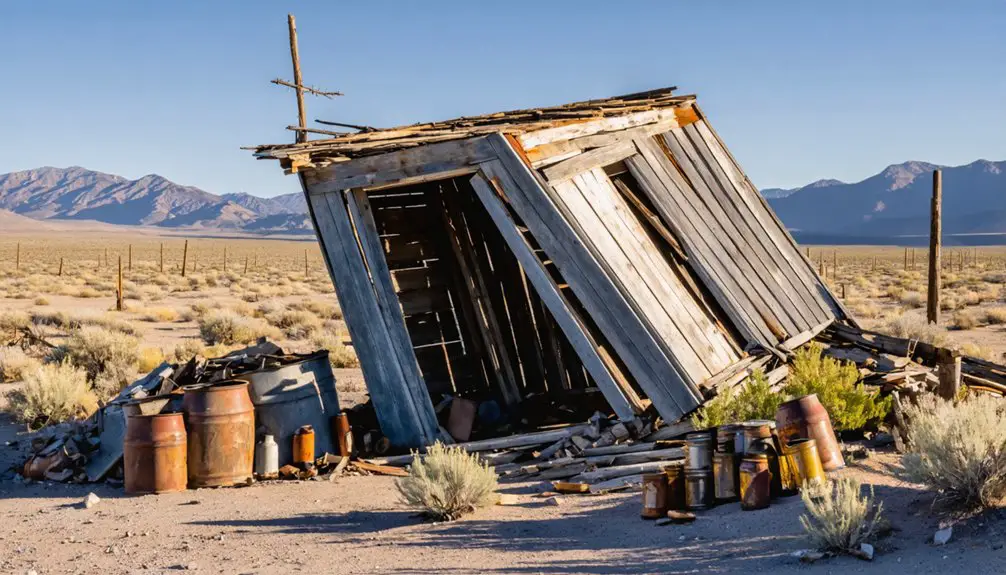You’ll find the haunting ruins of Delamar, Nevada, where a major gold discovery in 1890 sparked a mining boomtown that reached 3,000 residents by 1897. The town produced $25 million in gold during its peak years but gained infamy as “The Widow Maker” due to lethal silica dust that claimed hundreds of miners’ lives. Despite its wealth, including theaters and saloons, Delamar’s deadly working conditions and a devastating fire led to its eventual abandonment, leaving behind a complex legacy of prosperity and tragedy.
Key Takeaways
- Delamar was a thriving Nevada gold mining town established in 1892, reaching a peak population of 3,000 residents by 1897.
- The town earned the nickname “The Widow Maker” due to deadly silica dust from dry milling that caused widespread silicosis among miners.
- At its peak, Delamar’s mines produced $13.5 million in gold and silver, contributing over half of Nevada’s total ore production.
- The town featured amenities including theaters, saloons, a hospital, and cultural activities before its decline in the early 1900s.
- Today, Delamar stands as a ghost town, marked by abandoned structures and cemeteries that tell the story of its tragic past.
The Birth of a Golden Frontier

When John Ferguson and Joe Sharp stumbled upon gold in Nevada’s Pahranagat Valley in 1890, they set in motion a series of events that would transform this remote, treeless landscape into one of the state’s most significant mining districts.
You’ll find the roots of this gold rush in the early mining camps of Golden City, Helene, and Reeves, which sprouted up by 1892 as prospectors flocked to the area.
The Ferguson District‘s mining legacy began when John and Olivia Ferguson established their namesake camp in 1891. Despite being 150 miles from the nearest railroad, determined miners hauled materials across challenging terrain. By 1897, the area had grown into a thriving community of three thousand residents.
The district’s fate changed dramatically in 1893 when Captain John De Lamar purchased multiple claims for $150,000, consolidating the area and laying the groundwork for what would become Nevada’s third-richest mining district. The town’s prosperity peaked between 1895 and 1900, generating an impressive 13.5 million dollars in gold and silver production.
From Ferguson to Delamar: A Town’s Evolution
After its humble beginnings as Ferguson camp near Monkeywrench Wash in 1889, the settlement underwent a dramatic change under the ownership of Montana mining financier Joseph Raphael De Lamar.
The Ferguson origins trace back to prospectors John Ferguson and Joseph Sharp, who first discovered gold in the area. However, the real turning point came in 1893-1894 when De Lamar purchased and consolidated the key claims for $150,000, marking the Delamar shift. The settlement received essential supplies through mule team transport from Milford, Utah, covering a distance of 150 miles.
Following the installation of a 50-ton mill in 1895, the settlement rapidly evolved from a basic mining camp into a thriving town. By 1897, you’d have found a bustling community of over 3,000 residents, complete with stone-built businesses, a post office, newspaper, hospital, school, churches, and theater. The mine’s success was evident in its remarkable 25 million dollar gold production, establishing Delamar as Nevada’s leading gold producer at the turn of the century.
Mining Operations and Peak Production Years
During Delamar’s peak production years from 1895 to 1900, you’d find a bustling operation that dominated Nevada’s mining landscape, contributing over half of the state’s total ore production.
The mill’s expansion from its initial 50-ton capacity in 1895 to a 400-ton operation by 1903 reflected the mine’s growing success and technological advancement.
Transportation proved challenging yet essential to the operation’s success, with mule teams hauling materials across 150 miles from Milford, Utah’s railroad, while a sophisticated 12-mile water system sustained the mining camp’s extensive needs.
Daily Production Numbers
Throughout the late 19th century, Delamar’s mining operations reached staggering production levels that positioned the district as Nevada’s leading gold producer.
Daily ore processing saw a significant boost in 1903 when new owners installed a 400-ton mill, dramatically increasing the district’s output capacity compared to earlier dry milling methods. Production calculations were based on gold prices of $1,650 per ounce during operational assessments. The mine operated under the oversight of the Bamberger family from 1902 until closure in 1909.
While exact daily production estimates before 1903 aren’t documented in historical records, you’ll find that Delamar’s operations were substantial enough to account for half of Nevada’s mineral production between 1895 and 1900.
The district’s total output reached approximately $25 million in gold during its operational history. This remarkable yield made Delamar Nevada’s third richest mining district by 1906, trailing only behind Tonopah and Goldfield until the largest mine’s closure in 1909.
Mill Expansion Timeline
The mill expansion story at Delamar began in 1893 when John DeLamar invested $150,000 to consolidate the area’s most promising claims.
As ore processing demands grew, mill technology rapidly evolved to meet production needs. You’ll find the expansion followed a clear progression, transforming Delamar into Nevada’s leading mining district by 1895.
- Mid-1895: Initial 50-ton mill completed, replacing reliance on distant mills
- 1896: Additional 10-stamp mill constructed at April Fool mine, boosting daily capacity to 260 tons
- 1902: DeLamar sells his interests, leading to significant upgrades
- 1903: New owners construct massive 400-ton mill, cementing Delamar’s position as Nevada’s third-richest mining district
The expansions weren’t without costs – early dry milling created hazardous conditions, earning Delamar its grim nickname “The Widow Maker.”
Transportation and Supply Chain
Despite its remote location, Delamar’s mining operations relied on a complex supply chain anchored by mule team transport covering 150 miles from Milford, Utah’s railroad terminal.
You’d find mule teams hauling essential mining equipment, food provisions, and machinery across challenging mountainous terrain to sustain the town’s growing population, which reached 3,000 by 1897.
Transportation challenges extended to water supply, with an inadequate pipeline stretching 12 miles from Meadow Valley Wash.
Supply logistics improved after John De La Mar consolidated mining claims, enabling centralized management and operational scaling.
The completion of a 50-ton mill in 1895 reduced reliance on external processing, though the town’s remote location continued impacting costs and efficiency until its decline.
Despite these obstacles, Delamar managed to produce over half of Nevada’s minerals from 1895-1900.
Life in Nevada’s Deadly Boomtown

While you’d find theaters and saloons in thriving Delamar, miners faced lethal working conditions from silica-laden “Delamar dust” that earned the town its grim nickname “The Widow Maker.”
Despite the town’s hospital and professional medical services, silicosis ravaged the mining population, causing severe respiratory failure and high mortality rates.
Living conditions reflected the stark contrast between the town’s $13.5 million gold production wealth and the deadly toll on workers’ health, as miners’ families grappled with both prosperity and tragedy. After Captain John De Lamar purchased the mining claims in 1893, the town experienced rapid growth and development.
Deadly Mining Dust Effects
Living in Delamar during its mining heyday meant constant exposure to deadly crystalline silica dust, which permeated the air from extensive mining operations.
You’d face severe silica hazards as microscopic particles bypassed your lungs’ natural defenses, embedding deep within your air sacs. These deadly particles triggered devastating respiratory diseases, particularly silicosis – an incurable condition causing progressive lung scarring and inflammation.
The town’s reputation as “The Widow Maker” grew as countless miners succumbed to the toxic dust.
Key impacts of crystalline silica exposure:
- Persistent coughing, fever, and oxygen deprivation causing bluish skin
- Development of chronic conditions like lung cancer and emphysema
- Kidney damage from systemic autoimmune responses
- Reduced lung capacity leading to permanent respiratory distress
Without proper protective equipment or dust control measures, you’d risk these life-threatening conditions simply by breathing Delamar’s toxic air. MSHA data shows that over a quarter of miners experienced dangerous levels of air contaminant exposure.
Worker Living Conditions
The harsh realities of Delamar’s deadly dust extended far beyond the mines into every aspect of daily life. You’d find the pervasive quartzite dust seeping into homes, coating surfaces, and threatening the health of every resident – including women, children, and even animals.
Despite these grim conditions, worker satisfaction remained surprisingly high due to competitive wages exceeding $3 daily. Living expenses were offset by the town’s robust infrastructure, featuring an opera house, hospital, churches, and various shops. A meager forty gallons per minute of water flowed through the pipeline system, severely limiting the town’s ability to meet basic needs.
You’d discover a community determined to maintain cultural significance through brass bands, dances, and theatrical performances. However, the constant water scarcity meant inadequate dust suppression in both homes and workplaces.
The combination of fire-prone wooden buildings and lethal silicosis created an environment where residents lived under the shadow of impending mortality.
Healthcare During Mining Boom
Despite having a hospital and professional medical services, Delamar’s healthcare system struggled against an overwhelming tide of respiratory ailments caused by the notorious “Delamar Dust.”
In this remote Nevada boomtown, you’d find a medical infrastructure designed to handle typical mining injuries but woefully unprepared for the epidemic of silicosis that plagued its 3,000 residents.
Healthcare challenges were intensified by:
- Water scarcity that hindered sanitation and proper medical care
- Limited medical knowledge of occupational diseases during that era
- Remote location restricting access to advanced treatment options
- Overwhelming number of cases that strained available resources
You’d witness frontier doctors facing severe medical limitations while treating miners whose lungs were ravaged by silica dust.
The town’s nickname “The Widow Maker” reflected the harsh reality that local healthcare simply couldn’t combat the deadly toll of mining operations.
The Infamous “Widowmaker” Legacy

During Delamar’s peak mining years, silica dust from quartzite ore processing earned the town its grim nickname “Widowmaker,” as over 400 women became widows due to their husbands’ deaths from silicosis.
You’ll find evidence of this devastating silica exposure in the town’s cemeteries, where tombstones tell the tragic story of countless lives cut short. The health crisis affected not just miners but the entire community, as the fine “death dust” permeated the air throughout the settlement.
Despite processing up to 260 tons of ore daily and generating substantial wealth of $13.5 to $25 million in gold, the human cost was staggering. The widespread silicosis epidemic ultimately influenced mass migration away from Delamar by the early 1900s, though the town’s preserved ruins and cemeteries continue to serve as a sobering reminder of industrial negligence.
Devastating Fire and Community Resilience
While Delamar struggled with its “Widowmaker” reputation in 1900, a catastrophic fire originating from a barn devastated nearly half the town’s southern district.
You’ll find that Delamar’s community rebuilding efforts showcase remarkable resilience, as residents quickly reconstructed using native stone materials. With inadequate water resources for fire management, townspeople resorted to dynamiting buildings to halt the flames’ advance.
Key aspects of the fire’s impact and recovery:
- The town maintained civic functions, reopening businesses and establishing newspapers
- Mining operations continued, producing $8-8.5 million in gold by early 1900s
- Population peaked at 3,000 before declining post-fire
- Stone buildings replaced wooden structures, demonstrating adaptation to fire risks
Despite this recovery, the fire ultimately accelerated Delamar’s eventual decline, exposing critical vulnerabilities in the town’s infrastructure.
Decline of a Mining Empire

As Delamar reached its economic zenith in the late 1890s, producing $13.5 million in gold and silver between 1895-1900, multiple factors converged to trigger the town’s ultimate downfall.
You’ll find that economic decline accelerated after 1900 when a devastating fire ravaged the town’s infrastructure, forcing the use of dynamite to control the flames.
Within two years, John De Lamar‘s sale of his mining claims signaled the operation’s fragmentation.
Despite attempts to revive production with a 400-ton mill in 1903, the mining challenges proved insurmountable.
The absence of a major strike, coupled with depleting ore quality and technological limitations, made continued operations unprofitable.
Present-Day Ruins and Historical Landmarks
Today’s visitors to Delamar will find an impressive collection of native stone structures that have withstood over a century of harsh Mojave Desert conditions.
These architectural remnants distinguish Delamar from typical ghost towns, offering authentic glimpses into Nevada’s mining heritage. Present day preservation efforts focus on protecting these historical treasures from vandalism while maintaining access for ghost town exploration enthusiasts.
Delamar’s well-preserved stone buildings offer a rare window into Nevada’s mining past, protected today for future generations to explore.
Key features you’ll encounter include:
- Two historic cemeteries documenting the human cost of mining operations
- Mill site ruins showcasing gold and silver processing technologies
- Stone building remains constructed from local quartzite
- Extensive tailings fields evidencing industrial-scale mining
You’ll need a high-clearance 4WD vehicle to access the site, located 30 miles from the nearest town.
While camping is permitted, you’re urged to practice “Leave No Trace” ethics to protect these irreplaceable historical landmarks.
Frequently Asked Questions
What Happened to Captain De Lamar After Selling the Mines in 1902?
Like a savvy prospector chasing new riches, you’d find Captain De Lamar diving into Canadian mining ventures, leading Inco and Dome Mines while building his fortune through World War I until 1918.
Were There Any Famous People or Notable Residents in Delamar?
You’ll find two notable figures dominated Delamar’s history: Captain John De Lamar, who transformed the town through mining operations, and Simon Bamberger, who later controlled Nevada’s leading gold producer.
How Did Miners Spend Their Leisure Time in Delamar?
Like moths to flame, you’d find miners flocking to saloons, opera house shows, and brass band performances. You could enjoy theater productions, church gatherings, newspaper reading, and various social activities after work.
What Were the Typical Wages for Miners Working in Delamar?
You’d earn around $3 per day as a miner, which was considered good mining wages for the late 1800s, despite harsh labor conditions including deadly silica dust exposure.
Did Any Other Industries Besides Mining Exist in Delamar?
You’d find numerous businesses beyond mining, including freight services along transportation routes, plus stores, theaters, hospitals, and professional services – though there’s no evidence of significant agricultural activities.
References
- https://travelnevada.com/ghost-town/delamar-ghost-town/
- https://lincolncountynevada.com/exploring/wild-westing/ghost-towns/delamar-2/
- https://www.youtube.com/watch?v=Xe811XOOYbw
- https://pinintheatlas.com/travel-blogs/delamar-ghost-town/
- https://www.legendsofamerica.com/nv-delamar/
- https://www.nvexpeditions.com/lincoln/delamar.php
- https://westernmininghistory.com/towns/nevada/delamar/
- https://shpo.nv.gov/nevadas-historical-markers/historical-markers/delmar
- https://integraresources.com/asset/delamar-project/
- https://data-ndom.opendata.arcgis.com/pages/claims-commodities–occurrences



